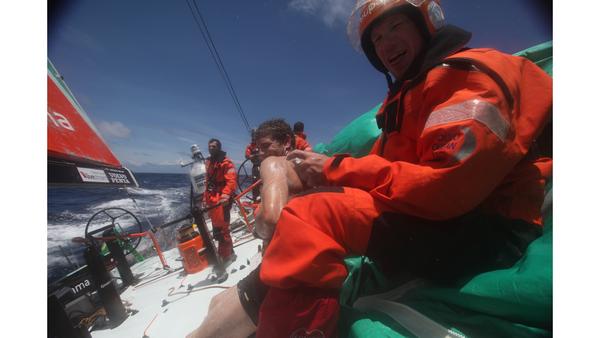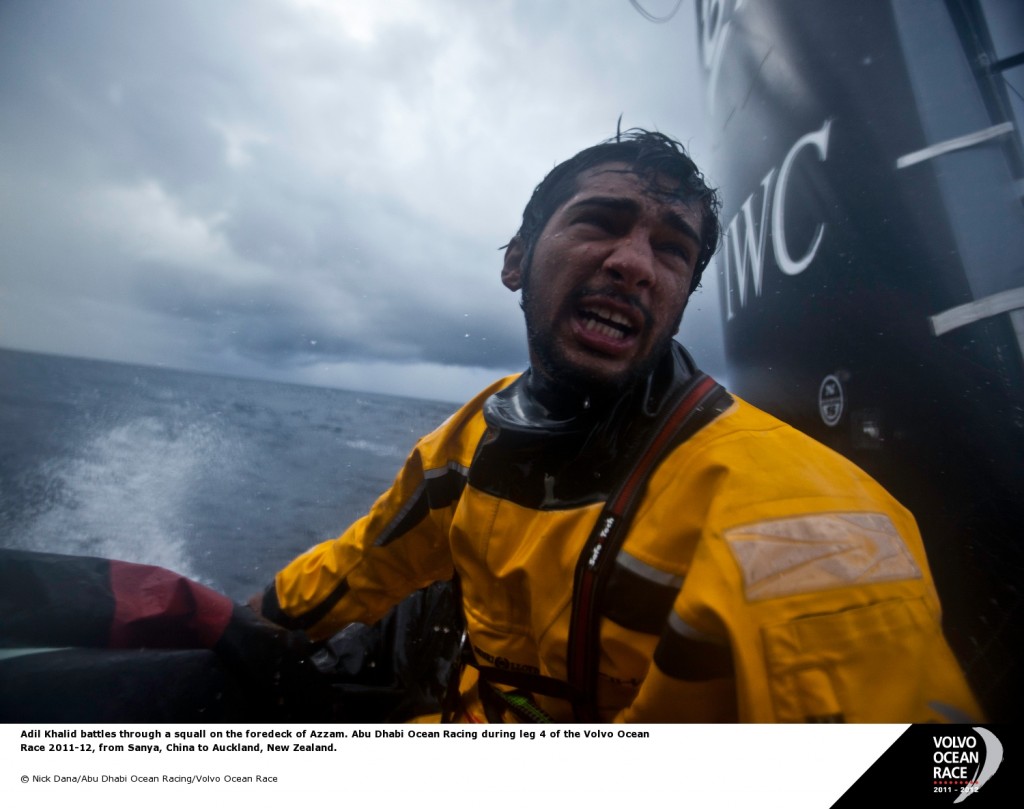
The fleet crossed the equator this Friday morning, but the danger zone is still in front of the six VO-70s. Indeed the Doldrums may not appear to be too developed, but they are lying in wait for them at the approach to the Melanesian archipelagos and the navigators will have to avoid cutting too tight a line near the islands, where the wind is very disturbed by the effects of convection. In the meantime, Groupama 4 has not only managed to hold onto her lead, but she’s also managed to get even further East than her rivals.
There was some concern at noon on Thursday when the tradewinds really began to drop away and especially when the squalls joined the playing field, causing very violent shifts in the north-easterly system, both in terms of strength and direction. Fortunately though, Franck Cammas and his men were able to quickly get back on the road which leads to the Coral Sea, between the island of San Cristobal (to the East of the Solomon archipelago) and the island of Nendo to the East (to the North of the Vanuatu archipelago). Though the breeze is now kicking out between 12 and 16 knots, it has also shifted round to the ESE (100°-110°), which is working against Groupama 4’s pursuers, and the boats further West in particular (Telefonica, Camper and Sanya).
Red zone
This touchdown on the large volcanic and coral arc which stretches from New Guinea to New Zealand, passing through the islands of Bismarck, Bougainville, Solomon, Vanuatu and New Caledonia, is a zone full of pitfalls. Indeed it marks the transition between the Pacific High and the lows of the area around Papua New Guinea and Australia. These pitfalls include the isobaric gradient which is pretty low, the Coriolis effect, which diverts the flow of air to the right in the northern hemisphere and to the left in the southern hemisphere and has little influence near the equator, as well as the large number of land masses, some of which are high and cause vortexes. As such it’s extremely hard to predict the true situation more than half a day ahead and the local effects may only affect a zone spanning a few dozen miles…
“I’ve got my fingers crossed for this third passage through the Doldrums: all you need is one bad squall to lose a huge amount of ground as the experience of our previous two equators has shown. The latest system appears less screwy but, with these islands in the mix, things may be affected by convection, which doesn’t show up on the grib files… After that, there are some strategic choices to be had, particularly around New Caledonia, since there will be a disturbance to the North of New Zealand. The last three days of racing aren’t easy and we’ll have to line ourselves up nicely in relation to this depression, which we don’t yet know how it will affect the fleet. Furthermore we may well round off with breezy downwind conditions or a lighter reaching wind, as the models have yet to come to an agreement on that one. We’ve traced a positive trajectory since setting out from Sanya. And even though there haven’t been a lot of options up for grabs, we’ve rarely been in difficulty as we’ve nicely negotiated the evolution of the weather. I hope that we’ll have the same clairvoyance and the same success up to the finish!” commented Franck Cammas.

Blue zone
This Friday the fleet has split into two groups, which are going to be striving to get as far away from the island of San Cristobal as possible (to the East of the Solomon archipelago): as such Groupama 4, Puma and Abu Dhabi are the best positioned to aim for the middle of this strait some 180 miles offshore. Telefonica, Camper and Sanya (between 180 and 200 miles to the West of the top trio), will find it a lot tougher to enter this passage, which is now only 500 miles ahead (two days at sea) and they have the possibility of two options. Either they can begin to sail closer to the wind, thus losing speed, so as to reposition themselves in the wake of the eastern group with a delta which could then exceed 200 miles, or they could take the risk of traversing the Solomon archipelago by slipping between Malaita and Guadalcanal, or going even further West between the islands of Choiseul and Santa Isabel!
The danger there is that may end up in the blue `parking’ zone, where they might be parked up for a while depending on how much current they run up against: the `toll’ could cost them very dear, as there would be more than 200 miles through which to run the gauntlet in this zone, with high levels of evaporation between the highly wooded land masses and a very hot sea… As such there’s a lot of convection at play in this zone, where cumulonimbus tend to form and `suck away’ the surrounding wind and shed great torrents of water on the area below them. The phenomenon is all the more pronounced at daybreak and at sunrise and the further the boats are from land, the less they’ll suffer the effects of convection.
Green zone
Early this weekend, the easterly tradewinds will gradually ease the further South the boats get and there is only likely to be around ten knots of breeze as they approach the archipelagos from Sunday (local time). Interestingly, Groupama 4 are likely to be further favoured by the fact that the prevailing breeze will be easterly, whilst it will be south-easterly offshore of the Solomon Islands. With a tighter angle to the wind, those boats in the West will find it increasingly hard to close down the lateral separation and it’s likely that they’ll be forced to traverse this `green zone’ of equatorial islands. Clearly the hypothesis is not designed to appeal to the navigators and crews, who will have to constantly have their eye on the radar to anticipate the squalls and make frequent manoeuvres to adapt the sail area…
This rainbow of zones (there are also likely to be some sublime colours over the next few days) look to be offering Franck Cammas and his men a good opportunity to shake off their pursuers, especially the Spanish, the New Zealanders and the Chinese. Let’s not kid ourselves though: the first to enter the “subequatorial turbulence zone” midway through the weekend will be Groupama 4, so we must expect a compression of the fleet in terms of distance to the finish. As such the 70-mile lead over the Americans will gradually melt away, but Puma would have quite a way to go before outmanoeuvring them!
Position of the competitors in the Volvo Ocean Race on the fourth leg from Sanya – Auckland at 1300 UTC on 02/03/2012
1. Groupama 4 some 2,256.50 miles from the finish
2. Puma – 70.10 miles astern of the leader
3. Abu Dhabi Ocean Racing – 110.20 miles astern of the leader
4. Telefonica – 110.90 miles astern of the leader
5. Camper – 131.90 miles astern of the leader
6. Team Sanya – 193.80 miles astern of the leader